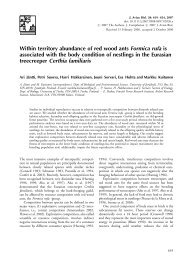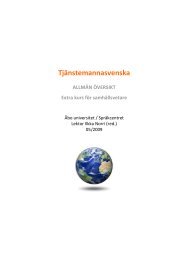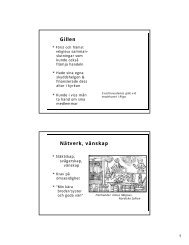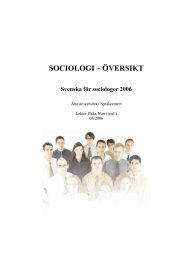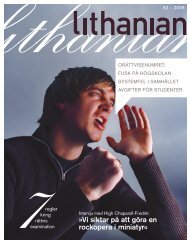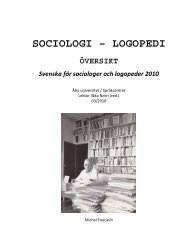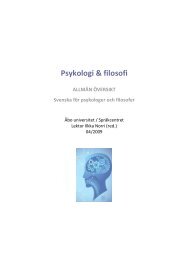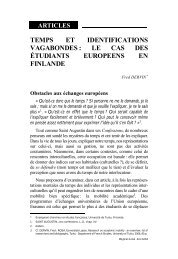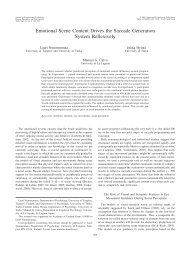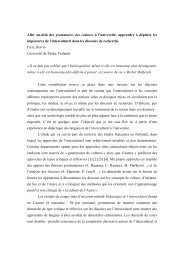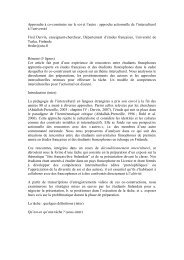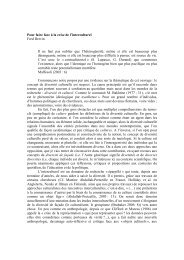Assessing intercultural competence in Language Learning and ...
Assessing intercultural competence in Language Learning and ...
Assessing intercultural competence in Language Learning and ...
Create successful ePaper yourself
Turn your PDF publications into a flip-book with our unique Google optimized e-Paper software.
<strong>Assess<strong>in</strong>g</strong> <strong><strong>in</strong>tercultural</strong> <strong>competence</strong> <strong>in</strong> <strong>Language</strong><br />
Learn<strong>in</strong>g <strong>and</strong> Teach<strong>in</strong>g: a critical review of current<br />
efforts<br />
Fred Derv<strong>in</strong><br />
La pensée savante s’est constituée contre la doxa, cette op<strong>in</strong>ion commune<br />
dont il fallait se distancier. Et elle est devenue ellemême doxa faite de<br />
conformisme <strong>in</strong>tellectuel, de politiquement correct, de moralisme rigide.<br />
Michel Maffesoli (2006: 5)<br />
Introduction<br />
Although it is not new <strong>in</strong> itself, the concept of “<strong><strong>in</strong>tercultural</strong>ity” has been<br />
flourish<strong>in</strong>g <strong>in</strong> recent decades <strong>in</strong> language education <strong>and</strong> has led to<br />
“<strong><strong>in</strong>tercultural</strong> talk”, i.e. an often uncritical, doxic (“taken for granted”, cf.<br />
Maffesoli’s criticism supra) <strong>and</strong> systematic use of the term <strong><strong>in</strong>tercultural</strong><br />
(Derv<strong>in</strong> 2009). This chapter endeavours to exam<strong>in</strong>e how it is understood <strong>and</strong><br />
worked upon <strong>in</strong> the field of language learn<strong>in</strong>g <strong>and</strong> teach<strong>in</strong>g <strong>and</strong> reflect on<br />
how it could be used <strong>in</strong> higher education. Despite impulsion from the work<br />
carried out by the Council of Europe, physical <strong>and</strong> virtual hypermobilities<br />
<strong>and</strong> the <strong>in</strong>ternationalization of higher education; regardless of the multiple<br />
research projects <strong>and</strong> publications on the topic, <strong><strong>in</strong>tercultural</strong>ity does not<br />
seem to have been entirely <strong>in</strong>tegrated <strong>in</strong>to language teach<strong>in</strong>g <strong>and</strong> learn<strong>in</strong>g <strong>in</strong><br />
this precise context. I shall deal here specifically with language departments.<br />
Nevertheless many of the po<strong>in</strong>ts raised <strong>in</strong> the chapter can also be of <strong>in</strong>terest<br />
to staff work<strong>in</strong>g <strong>in</strong> language centres.<br />
High levels of criticality <strong>and</strong> reflexivity are expected from university<br />
students (Barnett 1997). Yet, the humboldian <strong>and</strong> philological traditions,<br />
along with the proviso of academic freedom, which allows departments to<br />
decide upon their curricula <strong>and</strong> teachers to <strong>in</strong>troduce objectives which seem<br />
best suited for their educational context <strong>and</strong> which are close to their own<br />
research <strong>in</strong>terests, seem to have slowed down the expansion of a critical <strong>and</strong><br />
reflexive conception of <strong><strong>in</strong>tercultural</strong>ity <strong>and</strong> the development of <strong><strong>in</strong>tercultural</strong><br />
<strong>competence</strong> <strong>in</strong> higher education (Jaeger 1995: 267). In most language<br />
departments, the concept of <strong><strong>in</strong>tercultural</strong>ity has not had as much success as it<br />
deserves. Moreover, even when some departments <strong>in</strong>clude <strong><strong>in</strong>tercultural</strong>ity <strong>in</strong><br />
their programmes, there is no guarantee that the concept is understood <strong>in</strong> the
same way by teachers themselves <strong>and</strong> learners: <strong>in</strong> fact, <strong><strong>in</strong>tercultural</strong>ity is<br />
often confused with cultural, transcultural or multicultural approaches,<br />
which do not take on the same goals. Some teachers even assert that they<br />
<strong>in</strong>corporate “<strong><strong>in</strong>tercultural</strong>ity” while <strong>in</strong> fact what they <strong>in</strong>corporate is<br />
culturalism, i.e. “grammars of cultures” or unfounded facts/stereotypes about<br />
the Other.<br />
Some <strong>in</strong>itiatives are exceptions to the rule (cf. <strong><strong>in</strong>tercultural</strong> awareness<br />
<strong>in</strong> Great Brita<strong>in</strong>, Phipps & Gonzales 2004; Roberts et al. 2001; Kelly et al.<br />
2001 for a review of the state of the art <strong>in</strong> Europe; Corbett 2003 <strong>in</strong> Engl<strong>and</strong>;<br />
Derv<strong>in</strong> 2006a, 2007a <strong>in</strong> F<strong>in</strong>l<strong>and</strong> as well as the follow<strong>in</strong>g chapters). The<br />
variety of approaches <strong>in</strong> these <strong>in</strong>itiatives is so wide <strong>and</strong> eclectic that it seems<br />
difficult to provide a real synthesis. 1 Yet, as the concept of <strong><strong>in</strong>tercultural</strong>ity is<br />
complex <strong>and</strong> tends to receive manifold <strong>in</strong>terpretations, an archaeology of its<br />
underst<strong>and</strong><strong>in</strong>g is necessary more than ever, if we wish to consider its<br />
assessment.<br />
Intercultural <strong>competence</strong>, which is the expected outcome of the<br />
<strong>in</strong>sertion of <strong><strong>in</strong>tercultural</strong>ity <strong>in</strong> language learn<strong>in</strong>g <strong>and</strong> teach<strong>in</strong>g, is a vital<br />
<strong>competence</strong> <strong>in</strong> our contemporary world, especially (but not exclusively) for<br />
specialists <strong>in</strong>volved <strong>in</strong> mediat<strong>in</strong>g between people (diplomats, language<br />
teachers, consultants, journalists, translators… ). If one <strong>in</strong>troduces this<br />
<strong>competence</strong> <strong>in</strong> one’s teach<strong>in</strong>g, one needs to develop ways of mak<strong>in</strong>g sure<br />
that it is developed.<br />
This chapter is theoretical <strong>and</strong> exploratory <strong>in</strong> nature. It aims to<br />
del<strong>in</strong>eate different ways of work<strong>in</strong>g with <strong><strong>in</strong>tercultural</strong>ity <strong>and</strong> reflect on its<br />
assessment <strong>in</strong> language learn<strong>in</strong>g <strong>and</strong> teach<strong>in</strong>g <strong>in</strong> higher education. I will<br />
present a critical review of <strong><strong>in</strong>tercultural</strong> models, <strong>and</strong> share some reflections<br />
on models of <strong>competence</strong>s, which move beyond the canonical def<strong>in</strong>ition of<br />
<strong><strong>in</strong>tercultural</strong> <strong>competence</strong>, that can help teachers to work on assess<strong>in</strong>g it. To<br />
do so, two models of <strong><strong>in</strong>tercultural</strong> <strong>competence</strong> will be <strong>in</strong>troduced: one<br />
<strong>in</strong>spired by the work of Holliday et al. (2004) <strong>and</strong> one that I have developed<br />
myself over the last few years (Derv<strong>in</strong> 2004, 2006ab, 2007a).<br />
1. An archaeology of approaches to <strong><strong>in</strong>tercultural</strong>ity<br />
Intercultural <strong>competence</strong> is a concept that seems to be transparent,<br />
universally accepted, understood <strong>and</strong> (ab)used, but which has received many<br />
differ<strong>in</strong>g def<strong>in</strong>itions <strong>in</strong>side <strong>and</strong> outside academia. It is often made to do a<br />
1<br />
Cf. Crawshaw (2005) <strong>and</strong> Derv<strong>in</strong> (2006a) have specified these approaches.<br />
Anquetil (2006) can also serve as a good <strong>in</strong>troduction.
great deal of work e.g. <strong>in</strong> contemporary politics. In research it rema<strong>in</strong>s<br />
relatively fragmented, with little crosscutt<strong>in</strong>g discussion about<br />
methodology.<br />
Over decades of research on the <strong>competence</strong>, several phrases have<br />
been used (often <strong>in</strong>terchangeably (alas!)) to describe it: “crosscultural<br />
adaptation, <strong><strong>in</strong>tercultural</strong> sensitivity, multicultural <strong>competence</strong>, transcultural<br />
<strong>competence</strong>, global <strong>competence</strong> (… )” (Deardorff 2004: 32). It is so<br />
confus<strong>in</strong>g that I have proposed the concept of proteophilic <strong>competence</strong>s (the<br />
appreciation of the diverse diversities of the self <strong>and</strong> the other; Derv<strong>in</strong><br />
2006b, cf. below) to distance myself from current scientific <strong>and</strong> political use<br />
of the concept. Before that, every time I talked about <strong><strong>in</strong>tercultural</strong><br />
<strong>competence</strong>, other scholars assumed that we were “on the same<br />
wavelength”, even though our approaches differed.<br />
An archaeology of how <strong><strong>in</strong>tercultural</strong>ity is conceptualised <strong>in</strong> education<br />
is thus necessary <strong>in</strong> order to position oneself <strong>and</strong> make sure that when one<br />
uses the concept, those who listen or read, share a certa<strong>in</strong> number of<br />
theoretical, epistemological <strong>and</strong> philosophical elements. In this chapter, <strong>in</strong><br />
order to take stock of the conceptual <strong>and</strong> theoretical work <strong><strong>in</strong>tercultural</strong>ity is<br />
meant to do, I have chosen to concentrate on two of the anthropologist N.P.<br />
Pieterse’s three idealtype perspectives on culture (2004: 42), which are very<br />
useful <strong>in</strong> synthesiz<strong>in</strong>g how <strong><strong>in</strong>tercultural</strong>ity is understood <strong>and</strong> theorised. The<br />
model is composed of 1. Cultural differentialism, <strong>and</strong> 2. Cultural mélange or<br />
mix<strong>in</strong>g. To these two components, I have added a third one which I call<br />
Janusian approaches to <strong><strong>in</strong>tercultural</strong>ity.<br />
The first component, cultural differentialism, is based on the pr<strong>in</strong>ciple<br />
that people are different because of their “cultural belong<strong>in</strong>gs/baggage” <strong>and</strong><br />
that objective descriptions of people’s behaviours, thoughts, op<strong>in</strong>ions… can<br />
be provided. Accord<strong>in</strong>g to Pieterse, differentialists (culturalists or<br />
objectivists <strong>in</strong> my “parlance”) establish that the world is “a mosaic of<br />
immutably different cultures <strong>and</strong> civilizations” (2004: 55). In this model,<br />
cultural differences are def<strong>in</strong>ed as objective data allow<strong>in</strong>g <strong>in</strong>dividuals to<br />
underst<strong>and</strong> the behaviours of others (AbdallahPretceille 1999: 56). Pieterse<br />
(2004: 47) criticizes the differentialist approach by claim<strong>in</strong>g that the image<br />
of the mosaic is erroneous as it is composed of fixed discrete pieces,<br />
whereas human experience is fluid <strong>and</strong> openended. For A. Sen (2006: xvi),<br />
people are “m<strong>in</strong>iaturized” as they are reduced to one s<strong>in</strong>gle identity, that of a<br />
“culture” which is, <strong>in</strong> turn, reduced to national <strong>and</strong> geographical boundaries.<br />
This approach to differentiation has been shown to lead to stereotypical<br />
discourses <strong>and</strong> positive or negative representations on the Self <strong>and</strong> the Other<br />
(cf. Boli & Elliott’s “façade diversity” (2008). Most scholars <strong>in</strong>volved <strong>in</strong>
esearch<strong>in</strong>g <strong><strong>in</strong>tercultural</strong> <strong>competence</strong> seem to agree with this last argument,<br />
yet, as we shall see <strong>in</strong> the third category (Janusian approaches), many of<br />
them use e.g. culturespeak (Hannerz 2001) or discourses of s<strong>in</strong>gle <strong>and</strong><br />
unique identity which tend to contradict their criticisms of differentialism.<br />
The second component is based on the notion of “mélange” or<br />
“mix<strong>in</strong>g”. Accord<strong>in</strong>g to Pieterse (2004: 52), societies constantly live through<br />
openended, ongo<strong>in</strong>g mix<strong>in</strong>g, which leads to diverse diversities <strong>in</strong> terms of<br />
habits <strong>and</strong> artifacts, discourses <strong>and</strong> op<strong>in</strong>ions with<strong>in</strong> the same geographical<br />
boundaries (ibid., cf. also AbdallahPretceille 1999). This does not just refer<br />
to the fact that most societies conta<strong>in</strong> “foreign guests” or “representatives of<br />
other religions” but to the idea that WE are all diverse. The anthropologist<br />
adds that, even though mix<strong>in</strong>g is someth<strong>in</strong>g that is quite evident <strong>in</strong> everyday<br />
forms of be<strong>in</strong>g, it is not someth<strong>in</strong>g which is easily accepted. In research, this<br />
model is <strong>in</strong>creas<strong>in</strong>gly present through paradigms such as Mart<strong>in</strong>e Abdallah<br />
Pretceille’s “humanisme du divers” (a subjectivist approach to<br />
<strong><strong>in</strong>tercultural</strong>ity), hermeneutical <strong><strong>in</strong>tercultural</strong>ity (cf. the Nordic circle of<br />
hermeneutical <strong><strong>in</strong>tercultural</strong>ity represented amongst others by Dahl et al.<br />
2006) or proteophilia (Derv<strong>in</strong> 2007a), which consider <strong><strong>in</strong>tercultural</strong>ity, <strong>and</strong><br />
the related concepts of culture <strong>and</strong> identity, to be <strong>in</strong>tersubjective coconstructions<br />
<strong>and</strong> thus experiences as mélanges. Intersubjectivity<br />
emphasizes the fact that <strong>in</strong>dividuals are not free from all when they <strong>in</strong>teract<br />
<strong>and</strong> that they cannot identify freely – <strong>and</strong> more importantly that people can<br />
lie, manipulate discourses... The works of Adrian Holliday et al. (2004),<br />
Anwei Feng (2009) <strong>and</strong> Gav<strong>in</strong> Jack (2009) are also very close to this<br />
approach. The latter, for <strong>in</strong>stance, argues that: “epistemologically, I believe<br />
that a ‘dimensional’ approach to culture, which allows us to plot or map<br />
representatives of national cultures onto some k<strong>in</strong>d of cont<strong>in</strong>uum, presents<br />
students with unhelpfully fixed categories of analysis that essentialize<br />
culture <strong>and</strong> divest it of its key processual <strong>and</strong> political cont<strong>in</strong>gencies” (Jack<br />
2009: 96).<br />
The last category of <strong><strong>in</strong>tercultural</strong>ity, which I termed Janusian <strong>in</strong><br />
reference to the twofaced God, seems to be <strong>in</strong>creas<strong>in</strong>gly present <strong>in</strong> studies<br />
on <strong><strong>in</strong>tercultural</strong>ity <strong>in</strong> fields such as <strong><strong>in</strong>tercultural</strong> communication, language<br />
education, crosscultural psychology… As such a Janusian approach to<br />
<strong><strong>in</strong>tercultural</strong>ity is based on a misconception: on the one h<strong>and</strong>, the researchers<br />
defend <strong>and</strong> put forward the changeability <strong>and</strong> unstable nature of cultures,<br />
identities, “subjects” (i.e. the diverse diversities of each <strong>and</strong> every one of<br />
us), but on the other h<strong>and</strong>, through e.g. their corpus analyses, which resort to<br />
quantification or “soft” discourse analysis or contents analysis, they
categorise study participants <strong>in</strong>to national, religious, ethnic groups – <strong>and</strong> this<br />
limits the coconstructive aspects (Derv<strong>in</strong> 2009). 2<br />
It is now clear at the end of this archeology that position<strong>in</strong>g one’s<br />
research <strong>in</strong> one of these approaches cannot but have an impact on how<br />
concepts such as culture, identity, <strong><strong>in</strong>tercultural</strong>ity <strong>and</strong> <strong><strong>in</strong>tercultural</strong><br />
<strong>competence</strong> are theorized <strong>and</strong> put <strong>in</strong>to practice <strong>and</strong> is thus a necessary move.<br />
Two models derived from the mélange/subjectivist component will be<br />
presented <strong>in</strong> the last section of this chapter.<br />
2. A critical review of <strong><strong>in</strong>tercultural</strong> <strong>competence</strong><br />
Hundreds of def<strong>in</strong>itions of <strong><strong>in</strong>tercultural</strong> <strong>competence</strong> have been given by<br />
researchers worldwide (cf. Deardorff 2004 who provides a synthesis; cf. also<br />
her SAGE h<strong>and</strong>book of <strong><strong>in</strong>tercultural</strong> <strong>competence</strong> (2009); Byram 1997; Sercu<br />
2004; Guilherme 2000… 3 ).<br />
The most exhaustive <strong>and</strong> <strong>in</strong>fluential def<strong>in</strong>ition of <strong><strong>in</strong>tercultural</strong><br />
<strong>competence</strong> is that of Michael Byram (1997 <strong>and</strong> later). Byram has def<strong>in</strong>ed<br />
five savoirs (1997: 5053), or components of <strong><strong>in</strong>tercultural</strong> <strong>competence</strong>,<br />
which are complementary to a language learner’s communicative<br />
<strong>competence</strong> (the author actually calls it <strong><strong>in</strong>tercultural</strong> communicative<br />
<strong>competence</strong>). Byram has also been <strong>in</strong>volved <strong>in</strong> the <strong>in</strong>fluential Council of<br />
Europe’s Autobiography of Intercultural Encounters (www.coe.<strong>in</strong>t/lang).<br />
His model has a significant advantage compared to others: it sets clear<br />
objectives. However, as I shall comment upon later on, his savoirs are<br />
sometimes contradictory <strong>and</strong>/or based on unconv<strong>in</strong>c<strong>in</strong>g claims.<br />
For many of the other def<strong>in</strong>itions of <strong><strong>in</strong>tercultural</strong> <strong>competence</strong>, there is<br />
some sort of prêtàpenser (“readytoth<strong>in</strong>k”) on <strong><strong>in</strong>tercultural</strong>ity. Several<br />
misunderst<strong>and</strong><strong>in</strong>gs, one might even say misconceptions, seem to <strong>in</strong>fluence<br />
most of the def<strong>in</strong>itions of <strong><strong>in</strong>tercultural</strong> <strong>competence</strong>, <strong>and</strong> have an impact on<br />
their implementation <strong>in</strong> language learn<strong>in</strong>g <strong>and</strong> teach<strong>in</strong>g.<br />
First of all, the Norwegian anthropologist Unni Wikan po<strong>in</strong>ts to the<br />
“myth” that one encounters <strong>in</strong> many def<strong>in</strong>itions of <strong><strong>in</strong>tercultural</strong>ity – that of<br />
the encounter between cultures – when she writes: “I am struck by people’s<br />
2 For a very good example of Janusianism, cf. B. Hansen’s unstable <strong>and</strong> politically<br />
correct discourse on diverse diversities (http://www.afsfr.org<br />
/downloads/files/FRA/ La_gr<strong>and</strong>e_partie_cachée_de_l_iceberg.pdf) after a<br />
conference on student mobility <strong>in</strong> 2008. The famous objectivistculturalist M.<br />
3<br />
Bennett was one of the plenary speakers.<br />
Cf. Fant<strong>in</strong>i, A.E. (2006). Assessment tools of <strong><strong>in</strong>tercultural</strong> communicative<br />
<strong>competence</strong>. http://www.sit.edu/SITOccasionalPapers/feil_appendix_f.pdf. Cf.<br />
also Michael Byram <strong>and</strong> Geneviève Zarate (1997).
proclivity to talk as if culture were endowed with m<strong>in</strong>d, feel<strong>in</strong>g, <strong>and</strong><br />
<strong>in</strong>tention. Nor is this just a layperson’s way of speak<strong>in</strong>g. Academics,<br />
anthropologists <strong>in</strong>cluded, are as likely as anyone else to talk this way – as if<br />
culture had taken on a life of its own” (Wikan 2002: 83). As the<br />
anthropologist asserts, one does not meet cultures, but <strong>in</strong>dividuals. This<br />
“quasibiolisation” of cultures (Hannerz 2001: 42) is present <strong>in</strong> most<br />
def<strong>in</strong>itions of <strong><strong>in</strong>tercultural</strong> <strong>competence</strong>, e.g.: “the will<strong>in</strong>gness to engage with<br />
the foreign culture” (Sercu), “critical engagement with the foreign culture<br />
under consideration <strong>and</strong> one’s own” (Byram)…<br />
The second misconception is the impression that one gets, when<br />
read<strong>in</strong>g many def<strong>in</strong>itions of <strong><strong>in</strong>tercultural</strong> <strong>competence</strong>, that one’s culture (<strong>and</strong><br />
“identity”) <strong>and</strong> that of the other are s<strong>in</strong>gular. This is highlighted by Gabrielle<br />
Varro (2007: 36), who expla<strong>in</strong>s that:<br />
Even if one sticks to the restrictive mean<strong>in</strong>g of “encounter”, one of the<br />
problems that the concept of “<strong><strong>in</strong>tercultural</strong>ity” poses is that it leads to the<br />
idea of comb<strong>in</strong>ation, which, <strong>in</strong> turn, rests on the postulate that these<br />
objects that we refer to as cultures, before hav<strong>in</strong>g “met” each other, would<br />
have been untouched by any mélange (my translation).<br />
The ideas of the postmodern, hypermodern (Aubert 2004) <strong>and</strong> liquid<br />
(Bauman 2001) paradigms from the last decades, not only postulate that the<br />
concepts of culture <strong>and</strong> identity are outdated <strong>and</strong> cannot be used for analysis,<br />
but also propose that it would be better to substitute them with concepts that<br />
could help to translate the everchang<strong>in</strong>g nature <strong>and</strong> multiple constructions<br />
experienced by <strong>in</strong>dividuals. Mart<strong>in</strong>e AbdallahPretceille (1996) <strong>and</strong> Michel<br />
Maffesoli (1995) have put forward respectively the terms culturality <strong>and</strong><br />
identification <strong>in</strong> order to signal all these diverse “modalities of presence <strong>in</strong><br />
the world” (Hess & Weig<strong>and</strong> 2006: XII). Therefore, the feel<strong>in</strong>g of cultural<br />
homogeneity, which emerges from some def<strong>in</strong>itions, is “based on the<br />
positivist paradigm <strong>and</strong> more globally <strong>in</strong>spired by mechanistic scientism”<br />
(Boumard 2006: 1). This feel<strong>in</strong>g seems to suggest a superadaptation when<br />
“<strong>in</strong>terculturality” takes place (we might even go so far as to say<br />
acculturation: one supposedly becomes the other) by one of the <strong>in</strong>terlocutors<br />
<strong>and</strong> thus the acquisition of fixed cultural elements which allow a language<br />
user to communicate with a “native of the culture” (e.g. <strong>in</strong> terms of nonverbality,<br />
attitude). But it is more complicated than this: on a daily basis, we<br />
all have to <strong>in</strong>teract with very different people from our very own<br />
environments.<br />
It is <strong>in</strong>terest<strong>in</strong>g to note that, although language educationalists often<br />
refer to other fields <strong>in</strong> their writ<strong>in</strong>gs (anthropology, sociology,
philosophy… ), these ideas have not really ga<strong>in</strong>ed strength <strong>in</strong> many of the<br />
researchers’ conceptualisation of <strong><strong>in</strong>tercultural</strong> <strong>competence</strong> over the last<br />
decades – or if they have, the discourses that surround them are often<br />
unsteady.<br />
Another misunderst<strong>and</strong><strong>in</strong>g is rooted <strong>in</strong> the absence of the <strong>in</strong>terlocutor<br />
<strong>in</strong> most def<strong>in</strong>itions of <strong><strong>in</strong>tercultural</strong> <strong>competence</strong> (Ruben 1989: 234), which<br />
makes them quite monological <strong>and</strong> <strong>in</strong>dividualistic. Most def<strong>in</strong>itions only<br />
mention the “user” of the <strong>competence</strong> <strong>and</strong> ignore the <strong>in</strong>fluence of the<br />
<strong>in</strong>terlocutor <strong>and</strong> the context of <strong>in</strong>teraction on acts of <strong>in</strong>teraction. In fact, any<br />
<strong>in</strong>dividual can be absolutely “<strong><strong>in</strong>tercultural</strong>ly competent” but s/he may be<br />
easily troubled by the lack of motivation of the other, her/his bad <strong>in</strong>tentions,<br />
her/his language skills… . The <strong>in</strong>tegration of these acts of coconstruction of<br />
discourse <strong>and</strong> <strong>in</strong>teraction seems vital <strong>in</strong> the def<strong>in</strong>ition of <strong><strong>in</strong>tercultural</strong><br />
<strong>competence</strong>. Bas<strong>in</strong>g her reflections on a similar conclusion, Tania Ogay<br />
suggests that we use the term <strong><strong>in</strong>tercultural</strong> dynamics (2000: 53) rather than<br />
<strong>competence</strong> to describe this double responsibility <strong>and</strong> engagement.<br />
This is also related to another misconception: what I call the<br />
“researcher’s naïve belief <strong>in</strong> her/his subjects’ honesty”. Surpris<strong>in</strong>gly enough,<br />
there are quite many def<strong>in</strong>itions of <strong><strong>in</strong>tercultural</strong> <strong>competence</strong> which are based<br />
on what people have to say about what they feel about Others, what they<br />
have learnt about others… <strong>and</strong> not on how they say it. What Barker &<br />
Galas<strong>in</strong>ski (2001: 3) from the field of cultural studies have to say about<br />
culture is <strong>in</strong>spir<strong>in</strong>g: “it is best not to pursue the question “what is culture?”<br />
but rather to ask about how we talk about culture <strong>and</strong> for what purposes”.<br />
People have “une part d’ombre” (a shadow side) as Michel Maffesoli (2002)<br />
would say, which makes them manipulate, lie to others, etc. This cannot be<br />
ignored when we deal with someth<strong>in</strong>g as basic <strong>and</strong> primordial as<br />
<strong><strong>in</strong>tercultural</strong>ity.<br />
As we all know, there is a lack of reliability between acts <strong>and</strong><br />
discourse / discourse <strong>and</strong> acts: an <strong>in</strong>dividual may behave <strong>in</strong> an “appropriate”<br />
manner <strong>in</strong> a certa<strong>in</strong> situation, though he/she may be disgusted by his/her<br />
behaviour (cf. Derrida, 1976: 52; KerbratOrecchioni, 2002: 79). In his<br />
recent criticisms of his model of <strong><strong>in</strong>tercultural</strong> <strong>competence</strong> <strong>and</strong> the<br />
assessment of its components (savoirs, savoirfaire, savoirêtre… ), Byram<br />
(2008: 222) fails to p<strong>in</strong>po<strong>in</strong>t this important element: the scholar rightly<br />
claims that openness to others, critical selfawareness <strong>and</strong> self analysis are<br />
basic values <strong>in</strong> education, yet there is no way we can prove or test (or trust)<br />
if somebody genu<strong>in</strong>ely believes <strong>in</strong> them. Therefore assess<strong>in</strong>g these savoirêtre<br />
summatively is, to me, impossible. There is simply not enough evidence<br />
as all we often have is discourse, which cannot but be unstable, co
constructed, changeable… (cf. Derv<strong>in</strong> 2009). Students should be made<br />
aware of this vital aspect of <strong><strong>in</strong>tercultural</strong>ity – <strong>and</strong> of any act of human<br />
<strong>in</strong>teraction.<br />
F<strong>in</strong>ally, I share the position of G. Zarate (2003: 113), who makes a<br />
po<strong>in</strong>t of talk<strong>in</strong>g about <strong><strong>in</strong>tercultural</strong> <strong>competence</strong>s <strong>in</strong> the plural, as they can be<br />
found to be <strong>in</strong> various stages of unfixed development. In fact, the<br />
<strong>competence</strong>s are unstable <strong>in</strong> the sense that they are based not only on<br />
cognition, but also on affection <strong>and</strong> emotions. Therefore, as stated<br />
previously, a person who is “normally” competent <strong>in</strong> certa<strong>in</strong> contexts may<br />
be very <strong>in</strong>competent <strong>in</strong> other situations. Zarate (ibid.) adds that <strong><strong>in</strong>tercultural</strong><br />
<strong>competence</strong>s are not always calibrated with language skills <strong>and</strong> that an<br />
excellent comm<strong>and</strong> of a foreign language doesn’t automatically lead to good<br />
<strong><strong>in</strong>tercultural</strong> <strong>competence</strong>s <strong>and</strong> vice versa. Zarate also states that repeated<br />
contacts with citizens of a particular country do not mean perfect mastery of<br />
<strong><strong>in</strong>tercultural</strong> <strong>competence</strong>s.<br />
3. On assess<strong>in</strong>g <strong><strong>in</strong>tercultural</strong> <strong>competence</strong><br />
Our worlds are engraved with the “soft barbarity” of assessment (Le Goff<br />
1999) – a common practice <strong>in</strong> teach<strong>in</strong>g – because one cannot but assess as<br />
“learners tend not to pay attention to what is not assessed <strong>and</strong> therefore<br />
dem<strong>and</strong> that good assessment tools be developed” (Sercu 2004: 74, cf. also<br />
Søderberg 1995). Yet, most scholars who have worked on <strong><strong>in</strong>tercultural</strong><br />
<strong>competence</strong> have warned aga<strong>in</strong>st its assessment (Byram 1997; Kramsch<br />
1993; Zarate & Gohard 2004): how could we possibly achieve the four<br />
criteria of reliability, validity, fairness <strong>and</strong> consistency (Tagliante 1994) for<br />
<strong><strong>in</strong>tercultural</strong>ity?<br />
Many scholars <strong>and</strong> practitioners have tried to implement methods for<br />
assess<strong>in</strong>g <strong><strong>in</strong>tercultural</strong> <strong>competence</strong>s <strong>in</strong> their teach<strong>in</strong>g. First of all, there are<br />
st<strong>and</strong>ard cultural tests which consist of multiplechoice questions that are<br />
easy to adm<strong>in</strong>ister <strong>and</strong> correct (Hashem 1995: 1; cf. Ayosso <strong>in</strong> this volume),<br />
but which cannot provide <strong>in</strong>formation or evidence on somebody’s<br />
<strong><strong>in</strong>tercultural</strong> <strong>competence</strong> because they only test factual knowledge, which is<br />
sometimes generalised <strong>and</strong> stereotypical – especially when it refers to<br />
anthropological culture. Assessment tools, such as diagnostic scales (cf. for<br />
ex. Fant<strong>in</strong>i 2006; Allen & Herron 2003) which are composed of Likerttype<br />
items, have also been largely criticised. Ruben casts doubts on these tests,<br />
stat<strong>in</strong>g that: “the validity of data of this type rests fundamentally on the
presumption that respondents have the desire <strong>and</strong> ability to engage <strong>in</strong> valid<br />
selfassessment” (Ruben 1989: 231).<br />
Some scholars <strong>and</strong> practitioners have put forward the follow<strong>in</strong>g<br />
quantitative <strong>and</strong> qualitative methods of assessment:<br />
“Case studies, <strong>in</strong>terviews, analysis of narrative diaries, selfreport<br />
<strong>in</strong>struments observations by others/host culture, judgment by self <strong>and</strong><br />
others” (Deardoff 2006)<br />
“Surveys, evaluation forms (… ) reflective diary entries, critical <strong>in</strong>cident<br />
reports, <strong>in</strong>dividual <strong>and</strong> group <strong>in</strong>terviews… ” (Jackson 2005)<br />
Michael Byram suggests work<strong>in</strong>g from a portfolio that he calls an<br />
“autobiography of <strong><strong>in</strong>tercultural</strong> experiences”, which he describes <strong>in</strong> the<br />
follow<strong>in</strong>g manner (2005: 14):<br />
It is problemfocused, it only deals with experiences which reflect<br />
difference <strong>and</strong> there may be a tendency to focus on difficulties rather than<br />
pleasurable experiences, but “key experiences” are not necessarily difficult<br />
or problematic.<br />
Byram f<strong>in</strong>ally adds that it (ibid.): “requires a high degree of literacy <strong>and</strong><br />
analytical skill”, which many learners do not master because autonomous<br />
learn<strong>in</strong>g <strong>and</strong> the acquisition of <strong>competence</strong>s of analysis – <strong>and</strong> as paradoxical<br />
as it may be – require tra<strong>in</strong><strong>in</strong>g.<br />
All <strong>in</strong> all, many criticisms have been targeted at these attempts. Let’s<br />
have a look at some of those identified by Rubben (1989: 235). First of all,<br />
he states that if teachers ask students to keep diaries <strong>and</strong> logs, there is a<br />
subconscious belief that learners are honest <strong>and</strong> blunt about their<br />
experiences, while <strong><strong>in</strong>tercultural</strong> learn<strong>in</strong>g usually takes place through<br />
“vagabond learn<strong>in</strong>g” which the learner may not always want to share.<br />
Moreover, the analysis of the portfolios or diaries which is carried out by the<br />
teacher not only leads to big ethical problems, but also to problems of<br />
validity, <strong>in</strong>terpretation <strong>and</strong> objectivity. Also, <strong>in</strong> vivo observation of the<br />
students, for example, is problematic <strong>in</strong> terms of reliability <strong>and</strong> validity<br />
(which are essential criteria for assessment) as it tends to be subjective, coconstructed<br />
<strong>and</strong> <strong>in</strong>fluenced by many exterior factors such as the observer’s<br />
tiredness, emotions <strong>and</strong>/or representations (cf. Gillespie & Cornish 2009).<br />
Observation as such is always a construction of knowledge (Bensa 2008).<br />
4. New approaches to <strong><strong>in</strong>tercultural</strong> <strong>competence</strong> <strong>and</strong> assessment <strong>in</strong><br />
higher education: two proposals
This section exam<strong>in</strong>es two (<strong>in</strong>ter)subjectivitist models, which could be used<br />
for the development of <strong><strong>in</strong>tercultural</strong> <strong>competence</strong> 4 for language students <strong>in</strong><br />
higher education. The methods of assessment are mostly formative <strong>and</strong><br />
based not only on selfassessment <strong>and</strong> peer assessment, but also on potential<br />
summative assessment of the acquisition of taught savoirfaire (ex.<br />
<strong>competence</strong>s of discursive <strong>and</strong> enunciative analysis) by a “guide” (e.g. the<br />
teacher).<br />
Among the various approaches to <strong><strong>in</strong>tercultural</strong> <strong>competence</strong> presented<br />
<strong>in</strong> the first section, the subjectivist/mélange approach seems to be the most<br />
ethically acceptable alternative. The approach is based on an exam<strong>in</strong>ation of<br />
the coconstruction of identities <strong>and</strong> cultures <strong>and</strong> fully identifies itself <strong>in</strong><br />
hypermodern <strong>and</strong> postmodern analyses of our contemporary worlds <strong>and</strong><br />
concentrates above all on the development of savoirfaires <strong>and</strong> savoiranalyser<br />
(<strong>competence</strong>s of analysis). Savoiragir, which derives from the<br />
preced<strong>in</strong>g savoirs, could be taken <strong>in</strong>to consideration only for the doma<strong>in</strong>s<br />
that are of <strong>in</strong>terests here: university contexts (e.g. a learner has to prepare an<br />
argumentative presentation with a foreigner or take part <strong>in</strong> a forum on the<br />
<strong>in</strong>ternet <strong>in</strong> French as a l<strong>in</strong>gua franca with students from other countries),<br />
contexts of student mobility 5 <strong>and</strong> professional contexts (tra<strong>in</strong>eeship). Other<br />
doma<strong>in</strong>s of <strong>in</strong>teraction such as personal or familial contexts shouldn’t be<br />
considered.<br />
The first model which I f<strong>in</strong>d useful as it can be used for self, peer<strong>and</strong><br />
groupassessment but also <strong>in</strong> some ways for summative assessment<br />
(related academic savoirfaires can be assessed), is derived from Holliday,<br />
Hyde & Kullman’s 2004 book Intercultural Communication: An Advanced<br />
Resource Book. Though the authors do not present the follow<strong>in</strong>g model as a<br />
model of <strong><strong>in</strong>tercultural</strong> <strong>competence</strong>, to me it can work as such. The model is<br />
based on the three essential keywords of identity, otherization (how one<br />
turns an Other <strong>in</strong>to an Other), <strong>and</strong> representation. The summary of these<br />
items on pp. 4849 of the book can help set learn<strong>in</strong>g objectives <strong>and</strong> offer<br />
some tools for selfreflexion:<br />
4<br />
5<br />
IDENTITY<br />
Seek a deeper underst<strong>and</strong><strong>in</strong>g of <strong>in</strong>dividual people’s identity by<br />
I prefer to talk about the development of the <strong>competence</strong> rather than its<br />
acquisition as it is a fundamental “human” <strong>and</strong> “societal” <strong>competence</strong> which<br />
every one of us makes use of on a daily basis – successfully or not.<br />
Literature on various aspects of academic mobility is flourish<strong>in</strong>g, cf. Derv<strong>in</strong><br />
(2007c) <strong>and</strong> Byram & Derv<strong>in</strong> (2008).
a) avoid<strong>in</strong>g preconceptions<br />
b) appreciat<strong>in</strong>g complexity<br />
c) not overgeneralis<strong>in</strong>g from <strong>in</strong>dividual <strong>in</strong>stances.<br />
Achieve this by employ<strong>in</strong>g bracket<strong>in</strong>g to put aside your preconceptions, thick description<br />
to enable you to see complexity, <strong>and</strong> an appreciation of emergent data to signal the<br />
unexpected.<br />
1. respond to people accord<strong>in</strong>g to how you f<strong>in</strong>d them rather than accord<strong>in</strong>g to what you<br />
have heard about them<br />
2. avoid easy answers about how people are. Bracket – put aside simplistic notions<br />
about what is ‘real’ or ‘unreal’ <strong>in</strong> your perception of ‘another culture’<br />
3. appreciate that every society is as complex <strong>and</strong> culturally varied as your own.<br />
4. learn to build up thick descriptions of what happens between you <strong>and</strong> the others – to<br />
work out to communicate as you go along.<br />
5. while respect<strong>in</strong>g whatever people say about their own culture, take what they sat as<br />
evidence of what they wish to project rather than as <strong>in</strong>formation about where they<br />
come from.<br />
6. take what people say about their culture as a personal observation which should not<br />
be generalized to other people who come from the same background.<br />
7. underst<strong>and</strong> how people are creat<strong>in</strong>g <strong>and</strong> <strong>in</strong>deed negotiat<strong>in</strong>g their cultural identity <strong>in</strong><br />
the very process of communicat<strong>in</strong>g with us.<br />
8. appreciate that you are creat<strong>in</strong>g <strong>and</strong> negotiat<strong>in</strong>g your own cultural identity <strong>in</strong> the<br />
process of communicat<strong>in</strong>g with us.<br />
9. appreciate that the creation <strong>and</strong> negotiation of cultural <strong>and</strong> personal identity are the<br />
same th<strong>in</strong>g.<br />
OTHERIZATION<br />
Seek a deeper underst<strong>and</strong><strong>in</strong>g of the prejudices, preoccupations <strong>and</strong> discourses which lead<br />
you to otherize. Use this to enable bracket<strong>in</strong>g <strong>and</strong> to manage your own role <strong>in</strong><br />
communication.<br />
10. avoid fall<strong>in</strong>g <strong>in</strong>to the culturalist trap of reduc<strong>in</strong>g people to less than they are – <strong>in</strong> the<br />
same way as we must avoid racial <strong>and</strong> sexist traps.<br />
11. be aware that what happens between yourself <strong>and</strong> others is <strong>in</strong>fluenced very much by<br />
the environment with<strong>in</strong> which you are communicat<strong>in</strong>g <strong>and</strong> your own preoccupations.<br />
12. become aware of your own preoccupations <strong>in</strong> order to underst<strong>and</strong> what it is that<br />
people from other backgrounds are respond<strong>in</strong>g to.<br />
13. avoid be<strong>in</strong>g seduced by previous experience <strong>and</strong> the exotic<br />
14. monitor your own language <strong>and</strong> be aware of the destructive, culturalist discourses<br />
we might be conform<strong>in</strong>g to or perpetuat<strong>in</strong>g.<br />
REPRESENTATION<br />
Seek a deeper underst<strong>and</strong><strong>in</strong>g of the representations of the foreign Other which are<br />
perpetuated by society.<br />
15. be aware of the media, political <strong>and</strong> <strong>in</strong>stitutional <strong>in</strong>fluences <strong>in</strong> our own society which<br />
lead us to see people from other cultural backgrounds <strong>in</strong> a certa<strong>in</strong> way.<br />
16. see through these images <strong>and</strong> fictions when we encounter people from other cultural<br />
background, <strong>and</strong> always try to consider alternative representations.
17. be aware of dom<strong>in</strong>ant discourses which are easily perpetuated by the media, <strong>and</strong><br />
which lead us to ‘th<strong>in</strong>kasusual’ that familiar images of the foreign Other are<br />
‘normal’<br />
18. be aware that even images projected by sensitive, <strong>in</strong>tellectual sources can seduce our<br />
own sensitivities <strong>and</strong> <strong>in</strong>tellects <strong>in</strong>to th<strong>in</strong>k<strong>in</strong>g that they are ‘true’<br />
19. although sensationalism <strong>in</strong> the media is someth<strong>in</strong>g we know about <strong>and</strong> guard aga<strong>in</strong>st,<br />
we need to appreciate how deeply it exists <strong>in</strong> our traditional views of the foreign<br />
other.<br />
My own model of proteophilic <strong>competence</strong>s (i.e. the appreciation of the<br />
diverse diversities of the self <strong>and</strong> the other, Derv<strong>in</strong>, 2007ab, 2008, 2009) is<br />
<strong>in</strong> a way very similar to the previous. Three key elements have been used for<br />
their def<strong>in</strong>ition:<br />
The importance of relationships <strong>in</strong> <strong>in</strong>teraction is taken <strong>in</strong>to account <strong>in</strong> the<br />
coconstruction of identities <strong>and</strong> images of who one wants to be, how one<br />
presents oneself <strong>and</strong> the other <strong>in</strong> <strong>in</strong>teraction.<br />
Emphasis is also laid on the fact that each <strong>in</strong>dividual constructs<br />
themselves <strong>and</strong> that “<strong>in</strong> any act of <strong>in</strong>teraction, it is well known that one<br />
never communicates with the person as s/he really is, but with a<br />
representation which we have of him/her <strong>and</strong> his/her groups of belong<strong>in</strong>g,<br />
just as this person br<strong>in</strong>gs <strong>in</strong> the <strong>in</strong>teraction act her own representations”<br />
(Ogay, 2000: 166). The notions of representations <strong>and</strong> stereotypes are also<br />
at the heart of the various analyses that are proposed to students so that<br />
they learn to recognize these mechanisms of construction <strong>in</strong> their own<br />
discourse <strong>and</strong> <strong>in</strong> that of the other.<br />
The concept of “the fantasy of Unicity” (Maffesoli, 1995, i.e. the doxic<br />
idea that each of us has a unique self <strong>in</strong>side of them <strong>and</strong> that belong<strong>in</strong>g to<br />
one’s group makes us the “same”) as well as the concept of “dissociative<br />
acts”/diversity of the self borrowed from psychology (“situations <strong>in</strong> which<br />
I am somebody <strong>and</strong> somebody else at the same time” Boumard, 2006: 30 6 )<br />
are central. Through these concepts, the approach requires that the students<br />
decentre <strong>and</strong> look at themselves.<br />
Influenced by postmodern thought, theories of enunciation <strong>and</strong> dialogism<br />
(cf. Derv<strong>in</strong> 2009; Gillespie & Cornish 2009; L<strong>in</strong>ell 2009), the model is<br />
composed of three components: two savoirfaires <strong>and</strong> one savoirréagir/agir<br />
<strong>and</strong> form a whole. There is no progression (no “levels”) <strong>and</strong> it is open,<br />
flexible <strong>and</strong> should be reworked <strong>and</strong> adapted to learners’ needs. Every<br />
component (13) is expressed <strong>in</strong> the first person so that learners can use the<br />
model for selfassessment. One solution to each problem raised by the model<br />
is proposed so that learners may check their actions/reactions/strategies for<br />
6<br />
Cf. Derv<strong>in</strong>, 2007b for an adaptation of the concept <strong>in</strong> <strong><strong>in</strong>tercultural</strong><br />
communication.
adequacy, <strong>and</strong> decide upon objectives for themselves. The sections that<br />
follow the components (a to c) suggest reflections <strong>and</strong> question<strong>in</strong>gs that are<br />
necessary <strong>in</strong> order to enrich the <strong>competence</strong>.<br />
1. Savoirfaire I: Detect identification<br />
I am fully aware that every <strong>in</strong>dividual (myself <strong>in</strong>cluded) is multiple <strong>and</strong> complex but that<br />
every (<strong>in</strong>ter)locutor can adapt their discourse to contexts <strong>and</strong>/or <strong>in</strong>terlocutors by<br />
present<strong>in</strong>g a group or a national identity <strong>in</strong> order to please, confirm a representation or<br />
defend themselves. I know how to note <strong>and</strong> analyse pieces of evidence of identification <strong>in</strong><br />
my own discourse as well as <strong>in</strong> the other’s discourse.<br />
As a consequence, whenever possible, I try not to present myself or my <strong>in</strong>terlocutor<br />
through national images, stereotypes, generalisations <strong>and</strong> exaggerations…<br />
a.<br />
Individual plurality is not always visible because, <strong>in</strong> any context of <strong>in</strong>teraction, one needs<br />
to select an image of the self (<strong>and</strong> of the other) <strong>and</strong> use it. Moreover, classify<strong>in</strong>g by<br />
means of nationality is very common <strong>in</strong> <strong><strong>in</strong>tercultural</strong> encounters (it is often a start<strong>in</strong>g<br />
po<strong>in</strong>t, an overture). Also, I need to remember that tell<strong>in</strong>g somebody that they are us<strong>in</strong>g<br />
auto/heterostereotypes (“We F<strong>in</strong>ns are like this”) can be problematic because I can<br />
come across as moraliz<strong>in</strong>g <strong>and</strong>/or unpleasant. Who is entitled to forbid somebody from<br />
us<strong>in</strong>g a national autostereotype? What can thus be done <strong>in</strong> such a situation? I can play<br />
the stereotypegame, cut the conversation short, change topics, or discuss the stereotypes<br />
with my <strong>in</strong>terlocutor. With h<strong>in</strong>dsight, I can reflect on why I, or somebody else, used<br />
stereotypes <strong>in</strong> <strong>in</strong>teraction <strong>and</strong> how they were formulated.<br />
2. Savoirfaire II: Pay<strong>in</strong>g attention to discourses<br />
I am able to listen to discourses that I come across (m<strong>in</strong>e as well as others’) especially<br />
when they are potentially ethnocentric, xenophobic, racist but also exotic <strong>and</strong> xenophilic.<br />
I know how to ease such discourses by means of l<strong>in</strong>guistic markers such as modalities<br />
<strong>and</strong> be as explicit as possible by reformulat<strong>in</strong>g. I also try to avoid “<strong><strong>in</strong>tercultural</strong>ly<br />
correct”, naive or contradictory discourse on the self <strong>and</strong> the other such as “I have no<br />
stereotypes”, “I don’t believe <strong>in</strong> stereotypes but F<strong>in</strong>ns are… ” etc.<br />
b.<br />
This is where language skills can have a big impact on <strong><strong>in</strong>tercultural</strong> <strong>competence</strong>s (m<strong>in</strong>e<br />
<strong>and</strong> that of my <strong>in</strong>terlocutor) because one cannot always control all the mean<strong>in</strong>gs <strong>and</strong><br />
nuances <strong>in</strong> a foreign language <strong>and</strong> one can also shock one’s <strong>in</strong>terlocutor without even<br />
know<strong>in</strong>g (s/he may not even be show<strong>in</strong>g their real feel<strong>in</strong>gs <strong>in</strong> relation to this<br />
situation/context). What strategies could I use <strong>in</strong> such <strong>in</strong>stances without putt<strong>in</strong>g myself at<br />
risk?<br />
Secondly, the other can have a role to play <strong>in</strong> my use of language, with stereotypes be<strong>in</strong>g<br />
a case <strong>in</strong> po<strong>in</strong>t. For <strong>in</strong>stance, there might be times when my avoidance of stereotypes is<br />
limited by an <strong>in</strong>terlocutor whose position is hierarchically higher. How might I behave <strong>in</strong><br />
an ethical manner <strong>in</strong> such a situation <strong>and</strong> try not to resort to stereotypes?<br />
F<strong>in</strong>ally, I should bear <strong>in</strong> m<strong>in</strong>d that there is a potential gap between discourses <strong>and</strong> acts <br />
<strong>in</strong> other words, I am aware that discourse can be contradicted by actions <strong>and</strong> viceversa.<br />
3. Savoirréagir/agir: Controll<strong>in</strong>g one’s emotions/behaviours<br />
In delicate <strong>and</strong> difficult situations, situations of misunderst<strong>and</strong><strong>in</strong>g <strong>and</strong> disagreement, I<br />
make an effort to rem<strong>in</strong>d myself that <strong>in</strong>dividuals are human be<strong>in</strong>gs <strong>and</strong> that they have<br />
emotions, feel<strong>in</strong>gs, experience bad/good moods, personal problems… which <strong>in</strong>fluence
their reactions. As such, I try not to draw quick <strong>and</strong> culturalist conclusions which may<br />
harm my relationships with others.<br />
c.<br />
How might I therefore control my emotions <strong>in</strong> difficult situations? What strategies could<br />
be used to avoid conflicts or worsen<strong>in</strong>g situations?<br />
How might I go beyond feel<strong>in</strong>gs of déjàvu, déjàvécu, déjàdit… <strong>and</strong> phenomena of<br />
polyphony which may affect my relationships with others (e.g. a person rem<strong>in</strong>ds me of<br />
someone that I do not like either because of her/his physical appearance or his/her accent<br />
<strong>in</strong> a foreign language)?<br />
Conclusion<br />
(… ) pour dire, il faut savoir médire. Il n’y a pas de “pars construens” que<br />
si existe une “pars destruens”. En la matière, détruire les idées convenues<br />
et autres conformismes de pensées qui sont, justement, le fondement des<br />
multiples crispations dogmatiques. Ou qui, tout simplement, confortent les<br />
diverses paresses <strong>in</strong>tellectuelles, les lieux communs, et autres expressions<br />
des bons sentiments.<br />
Michel Maffesoli (2006: 8)<br />
The article has allowed us to look at the miscellaneous <strong>in</strong>terpretations of<br />
<strong><strong>in</strong>tercultural</strong> <strong>competence</strong> conta<strong>in</strong>ed <strong>in</strong> the literature on <strong><strong>in</strong>tercultural</strong>ity <strong>and</strong><br />
especially <strong>in</strong> language education. The models that were proposed <strong>in</strong> the last<br />
section represent examples of learn<strong>in</strong>g/teach<strong>in</strong>g objectives of<br />
<strong><strong>in</strong>tercultural</strong>ity, which can be set for a whole university course, <strong>and</strong> can be<br />
constantly remodelled, transformed, criticised… The assessment of the<br />
<strong>competence</strong> should comb<strong>in</strong>e formative <strong>and</strong> summative assessment through a<br />
panoply of methods, contexts <strong>and</strong> actors. If tools such as discourse analysis<br />
or dialogism are used to complement these approaches (cf. Derv<strong>in</strong> forth.),<br />
the <strong>competence</strong> can be assessed summatively, as one would expect<br />
university students to be able to demonstrate that they have acquired such<br />
tools to provide “objective” analysis of data.<br />
This has some consequences on lecturers, because they also have to<br />
recognise <strong>and</strong> accept that they are not the absolute masters <strong>in</strong> lecture halls:<br />
they must also be aware of his/her emotions, representations, contradictory<br />
discourses… Furthermore, they can no longer assume that they are always<br />
able to judge the development of learners’ <strong><strong>in</strong>tercultural</strong> <strong>competence</strong> by<br />
simply exam<strong>in</strong><strong>in</strong>g their written or oral speech, because it is unstable,<br />
ambiguous <strong>and</strong> calculated (i.e. students sometimes offer readymade<br />
answers to please the teacher). Teachers can however guide learners <strong>in</strong> the<br />
acquisition of savoirfaire <strong>and</strong> savoiranalyser which will allow them to<br />
reflect <strong>and</strong> act.
Intercultural <strong>competence</strong> is not permanent, “for life”, <strong>and</strong> its practice<br />
<strong>and</strong> learn<strong>in</strong>g never end. If we accept the idea of lifelong learn<strong>in</strong>g (a notion<br />
which is adulated by the EU), <strong><strong>in</strong>tercultural</strong>ity is without a doubt one of its<br />
best <strong>in</strong>carnations because it is one of the doma<strong>in</strong>s where “man cannot but<br />
reach imprecision” (Jules Supervielle). The new approaches to<br />
<strong><strong>in</strong>tercultural</strong>ity presented <strong>in</strong> this chapter are part of the necessary “pars<br />
destruens” <strong>in</strong> the “pars construens” (cf. Maffesoli supra) that researchers<br />
should endeavour to create.<br />
Bibliography<br />
AbdallahPretceille, M. 1999. L’éducation <strong>in</strong>terculturelle. Paris: Presses<br />
Universitaires de France. Que saisje ?<br />
AbdallahPretceille, M. 1996. Vers une pédagogie <strong>in</strong>terculturelle. Paris:<br />
Anthropos.<br />
Allen, H. & C. Herron 2003. “A mixedmethodology <strong>in</strong>vestigation of the<br />
l<strong>in</strong>guistic <strong>and</strong> affective outcomes of summer study abroad”. Foreign<br />
language annals 36 (3), 370385.<br />
Anquetil, M. 2006. Mobilité Erasmus et communication <strong>in</strong>terculturelle.<br />
Collection Transversales. Bern : Peter Lang.<br />
Aubert, N. 2004. L’<strong>in</strong>dividu hypermoderne. Ramonville Sa<strong>in</strong>tAgne:<br />
Collection Sociologie Cl<strong>in</strong>ique. Éditions Erès.<br />
Barker, C. & D. Galas<strong>in</strong>ski 2001. Cultural studies <strong>and</strong> discourse analysis.<br />
London: Sage.<br />
Barnett, R. 1997. Higher education: a critical bus<strong>in</strong>ess. Buck<strong>in</strong>gham: SRHE<br />
& Open University Press.<br />
Bauman, Z. 2001. Liquid modernity. Cambridge : Polity press.<br />
Bensa, A. 2008. “Remarques sur les politiques de l’<strong>in</strong>tersubjectivité”. In :<br />
Fass<strong>in</strong> D. & A. Bensa (eds.). Les politiques de l’enquête. Epreuves<br />
ethnographiques. Paris : La Découverte, 323328.<br />
Boli, J., & M.A. Elliott 2008. “Façade diversity: The <strong>in</strong>dividualization of<br />
cultural difference”. International Sociology 23, 540560.<br />
Boumard, P. 2006. “Introduction”. In : Boumard, P., Lapassade, G. & M.<br />
Lobrot. Le mythe de l’identité. Apologie de la dissociation. Paris :<br />
Anthropos, 110.<br />
Byram, M., & F. Derv<strong>in</strong> (eds.). 2008. Student, staff <strong>and</strong> academic mobility <strong>in</strong><br />
higher education. Newcastle: Cambridge Scholars Publish<strong>in</strong>g.<br />
Byram, M. 2008. From foreign language education to <strong><strong>in</strong>tercultural</strong><br />
citizenship. Clevedon: Multil<strong>in</strong>gual Matters.
Byram, M. & G. Zarate 1997. Sociocultural <strong>competence</strong> <strong>in</strong> language<br />
learn<strong>in</strong>g <strong>and</strong> teach<strong>in</strong>g. Strasbourg: Council of Europe.<br />
Byram, M. 1997. Teach<strong>in</strong>g <strong>and</strong> assess<strong>in</strong>g <strong><strong>in</strong>tercultural</strong> communicative<br />
<strong>competence</strong>. Clevedon: Multil<strong>in</strong>gual Matters Ltd.<br />
Byram, M. 2005. European <strong>Language</strong> Portfolio. Theoretical model <strong>and</strong><br />
proposed template for an autobiography of ‘key <strong><strong>in</strong>tercultural</strong><br />
experiences’. Strasbourg, <strong>Language</strong> Policy Division: Council of<br />
Europe.<br />
Chen, G.M. & W.J. Starosta 1996. “Intercultural <strong>competence</strong>: a synthesis”.<br />
Communication Yearbook 19,353383.<br />
Corbett, J. 2003. Intercultural approach to English language teach<strong>in</strong>g.<br />
Clevedon: Multil<strong>in</strong>gual Matters.<br />
Crawshaw, R. 2005. Intercultural awareness as a component of HE Modern<br />
language courses <strong>in</strong> the UK.<br />
http://www.llas.ac.uk/resources/goodpractice.aspx?resourceid=2303<br />
Dahl, Ø, Jensen, I & P. Nynäs 2006. Bridges of underst<strong>and</strong><strong>in</strong>g. Perspectives<br />
on <strong><strong>in</strong>tercultural</strong> communication. Oslo: Unipub.<br />
Deardorff, D. 2004. The identification <strong>and</strong> assessment of <strong><strong>in</strong>tercultural</strong><br />
<strong>competence</strong> as a student outcome of <strong>in</strong>ternationalization at<br />
<strong>in</strong>stitutions of higher education <strong>in</strong> the United States. Unpublished PhD<br />
dissertation. North California State University.<br />
Deardorff, D. 2006. “Identification <strong>and</strong> assessment of <strong><strong>in</strong>tercultural</strong><br />
<strong>competence</strong> as a student outcome of <strong>in</strong>ternationalization”. Journal of<br />
Studies <strong>in</strong> International Education 10 (3), 241266.<br />
Deardorff, D. 2009 (ed.). The Sage H<strong>and</strong>book Of Intercultural Competence.<br />
London: Sage.<br />
Derrida, J. 1976. Of grammatology. Baltimore: John Hopk<strong>in</strong>s University<br />
Press.<br />
Derv<strong>in</strong>, F. 2004. “Déf<strong>in</strong>ition et évaluation de la compétence <strong>in</strong>terculturelle<br />
en contexte de mobilité : ouvertures”. Moderna språk XCVIII (1), 68<br />
77.<br />
Derv<strong>in</strong>, F. 2006a. “Reflections on the Decondition<strong>in</strong>g of <strong>Language</strong><br />
Specialists <strong>in</strong> F<strong>in</strong>nish Higher Education”. In: Derv<strong>in</strong>, F. & E.<br />
SuomelaSalmi (eds.). Intercultural Communication <strong>and</strong> Education.<br />
F<strong>in</strong>nish Perspectives. Bern: Peter Lang, 105127.<br />
Derv<strong>in</strong> F. 2006b. “Quality <strong>in</strong> Intercultural Education: the Development of<br />
Proteophilic Competence”. EUBildung 2010, Regionalveranstaltung<br />
fur Wien, Niederosterreich und Burgenl<strong>and</strong>. BM: BWK, Stadtschulrat<br />
fur Wien, 7587.
Derv<strong>in</strong> F. 2007. “Dissociation <strong>and</strong> “complex” <strong><strong>in</strong>tercultural</strong>ity”. In: Research<br />
Papers International NordicBaltic conference of the World<br />
Federation of <strong>Language</strong> Teacher Associations (FIPLV) “Innovations<br />
<strong>in</strong> <strong>Language</strong> Teach<strong>in</strong>g <strong>and</strong> Learn<strong>in</strong>g <strong>in</strong> the Multicultural Context”.<br />
Riga, 1516 June 2007. Riga: SIA “ Izglbas soi”, 5964.<br />
Derv<strong>in</strong>, F. 2009. “Transcend<strong>in</strong>g the culturalist impasse <strong>in</strong> stays abroad:<br />
help<strong>in</strong>g mobile students to appreciate diverse diversities”. Frontiers,<br />
the <strong>in</strong>terdiscipl<strong>in</strong>ary journal of study abroad. Volume XVIII, Fall<br />
2009.<br />
Derv<strong>in</strong>, F. Forth. “Approches dialogiques et énonciatives de l’<strong>in</strong>terculturel :<br />
pour une didactique des langues et de l’identité mouvante des sujets”.<br />
Synergies Roumanie.<br />
Fant<strong>in</strong>i, A.E. 2006. Assessment tools of <strong><strong>in</strong>tercultural</strong> communicative<br />
<strong>competence</strong>. http://www.sit.edu/publications/docs/feil_appendix_f.pdf<br />
Feng, A.W. 2009. “Becom<strong>in</strong>g <strong><strong>in</strong>tercultural</strong>ly competent <strong>in</strong> a third space”. In:<br />
Feng, A.W., Byram, M. & M. Flem<strong>in</strong>g (eds.). Becom<strong>in</strong>g<br />
<strong><strong>in</strong>tercultural</strong>ly competent through education <strong>and</strong> tra<strong>in</strong><strong>in</strong>g. Clevedon:<br />
Multil<strong>in</strong>gual Matters, 7191.<br />
Gillespie, A. & Cornish, F. 2009 (<strong>in</strong> press). Intersubjectivity: Towards a<br />
dialogical analysis. Journal for the Theory of Social Behaviour.<br />
Guilherme, M. 2000. “Intercultural <strong>competence</strong>”. In: Byram, M. (ed.).<br />
Routledge encyclopedia of language teach<strong>in</strong>g <strong>and</strong> learn<strong>in</strong>g. London:<br />
Routledge, 297299.<br />
Hannerz, U. 2001. “Reflections on Varieties of Culturespeak”. European<br />
journal of cultural studies 2 (3), 393407.<br />
Hashem, M.E. 1995. <strong>Assess<strong>in</strong>g</strong> student learn<strong>in</strong>g outcome <strong>in</strong> teach<strong>in</strong>g<br />
<strong><strong>in</strong>tercultural</strong> communication. Speech communication association<br />
convention. San Antonio, Texas.<br />
http://eric.ed.gov/ERICDocs/data/ericdocs2/content_storage_01/0000<br />
00b/80/26/04/92.pdf.<br />
Hess, R. & G. Weig<strong>and</strong> 2006. “De la dissociation à l’autre logique. Préface”.<br />
In : Boumard, P., Lapassade, G. & M. Lobrot. Le mythe de l’identité.<br />
Apologie de la dissociation. Paris : Anthropos, IXXXIII.<br />
Holliday, A., Hyde, M. & J. Kullman 2004. Intercultural communication.<br />
London: Routledge.<br />
Jack, G. 2009. “A critical perspective on teach<strong>in</strong>g <strong><strong>in</strong>tercultural</strong> <strong>competence</strong><br />
<strong>in</strong> a management department”. In: Feng, A., Byram, M. & M. Flem<strong>in</strong>g<br />
(eds.). Becom<strong>in</strong>g <strong>in</strong>tercultually competent through education <strong>and</strong><br />
tra<strong>in</strong><strong>in</strong>g. Clevedon: Multil<strong>in</strong>gual Matters, 93115.
Jackson, J. 2005. “<strong>Assess<strong>in</strong>g</strong> Intercultural learn<strong>in</strong>g though <strong>in</strong>trospective<br />
accounts”. Frontiers, 165186.<br />
Jæger, K. 1995. “Teach<strong>in</strong>g <strong><strong>in</strong>tercultural</strong> <strong>competence</strong> to university students”.<br />
In: Jensen, A.A., Jæger, K. & A. Lorentsen (eds.). Intercultural<br />
<strong>competence</strong>. A new challenge for language teachers <strong>and</strong> tra<strong>in</strong>ers <strong>in</strong><br />
Europe. Volume II: the adult learner. Aalborg: Centre for languages<br />
<strong>and</strong> <strong><strong>in</strong>tercultural</strong> studies, Aalborg University, Denmark, 265285.<br />
Kelly, M., Elliott, I. & L. Fant (eds) (2001). Third space, third level:<br />
<strong><strong>in</strong>tercultural</strong> communication <strong>and</strong> language <strong>in</strong> European higher<br />
education. Bern: Peter Lang.<br />
KerbratOrecchioni, C. 2002. L’énonciation. Collection U. Paris: Arm<strong>and</strong><br />
Col<strong>in</strong>.<br />
Kramsch, C. 1993. Context <strong>and</strong> Culture <strong>in</strong> <strong>Language</strong> Teach<strong>in</strong>g. Oxford:<br />
Oxford University Press.<br />
Le Goff, J.P. 1999. La barbarie douce. La modernisation aveugle des<br />
entreprises et de l’école. Paris: La Découverte.<br />
L<strong>in</strong>ell, P. 2009. Reth<strong>in</strong>k<strong>in</strong>g <strong>Language</strong>, M<strong>in</strong>d, <strong>and</strong> World Dialogically. NY:<br />
Information Age Pub Inc.<br />
Maffesoli, M. 1995. The Time of the Tribes: the Decl<strong>in</strong>e of Individualism <strong>in</strong><br />
Mass Society. London: Sage.<br />
Ogay, T. 2000. De la compétence à la dynamique <strong>in</strong>terculturelles. Bern:<br />
Peter Lang.<br />
Phipps, A. & M. Gonzalez 2004. Modern languages: Learn<strong>in</strong>g <strong>and</strong> teach<strong>in</strong>g<br />
<strong>in</strong> an <strong><strong>in</strong>tercultural</strong> field. London: Sage.<br />
Pieterse, J.N. 2004. Globalization <strong>and</strong> Culture: Global Mélange. Lanham:<br />
Rowman & Littlefield Publishers.<br />
Roberts, C., Byram, M., Barro, A. Jordan, S. & B. Street 2001. <strong>Language</strong><br />
learners as ethnographers. Clevedon: Multil<strong>in</strong>gual Matters Ltd.<br />
Ruben, B.D. 1989. “The study of crosscultural <strong>competence</strong>s: traditions <strong>and</strong><br />
contemporary issues”. International journal of <strong><strong>in</strong>tercultural</strong> relations<br />
13, 229240.<br />
Sen, A. 2006. Identity <strong>and</strong> Violence. The illusion of dest<strong>in</strong>y. New Delhi:<br />
Pengu<strong>in</strong>.<br />
Sercu, L. 2004. “<strong>Assess<strong>in</strong>g</strong> <strong><strong>in</strong>tercultural</strong> <strong>competence</strong>: a framework for<br />
systematic test development <strong>in</strong> foreign language education <strong>and</strong><br />
beyond”. Intercultural education 15 (1), 7389.<br />
Søderberg, A.M. 1995. “Teach<strong>in</strong>g (<strong>in</strong>ter)cultural awareness”. In: Jensen,<br />
A.A., Jæger, K. & A. Lorentsen (eds.). Intercultural <strong>competence</strong>. A<br />
new challenge for language teachers <strong>and</strong> tra<strong>in</strong>ers <strong>in</strong> Europe. Volume
II: the adult learner. Aalborg: Centre for languages <strong>and</strong> <strong><strong>in</strong>tercultural</strong><br />
studies, Aalborg University, Denmark, 285305.<br />
Tagliante, C. 1994. L’évaluation. Paris : Clé Internationale.<br />
Varro, G. 2007. “Les présupposés de la notion d’<strong>in</strong>terculturel. Réflexions sur<br />
l’usage du terme depuis trente ans”. Synergies Chili, 3544.<br />
Wikan, U. 2002. Generous betrayal. Politics of culture <strong>in</strong> the new Europe.<br />
Chicago: the University of Chicago press.<br />
Zarate, G. 2003. “Identities <strong>and</strong> pluril<strong>in</strong>gualism: preconditions for the<br />
recognition of <strong><strong>in</strong>tercultural</strong> <strong>competence</strong>s”. In: Byram, M. (ed).<br />
Intercultural <strong>competence</strong>. Strasbourg: Council of Europe Publish<strong>in</strong>g.<br />
Zarate, G. & A. GohardRadenkovic (eds.) 2004. La reconnaissance des<br />
compétences <strong>in</strong>terculturelles: de la grille à la carte. Paris: Didier<br />
FLE.




